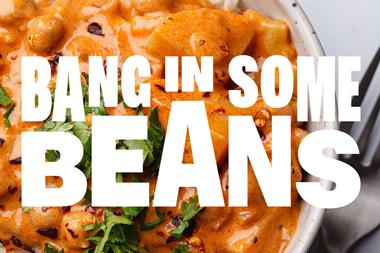The battle for market share in cooking sauces is as intense as ever, but the brands gaining most ground are the same ones steering clear of heavy promotions. Guy Sheppard reports
The mainstays of the cooking sauce market continue to enjoy comfortable growth, but Britain's ongoing love affair with curry threatens to upset the status quo.
Middle-class consumers no longer able to stretch to regular restaurant meals are instead opting for Indian cooking sauces, at the expense of the more established sauces, such as Italian and traditional.
Indian is the only sub-sector to outpace the 2.9% value growth shown by the overall category. Its 7.4% rise in value due at least partly to price increases far outstrips that of Italian and traditional sauces, which jointly account for two-thirds of the entire £679m cooking sauces market [Kantar Worldpanel 52w/e 28 November 2010]. And while it was one of a number of categories that posted strong growth in 2009, in 2010 it was the only sub-category.
However, the key reasons for Indian's solid progress, says Kantar analyst Federico Cucchi, is that Indian sauces have not been promoted as heavily as most of the other sub-sectors. And, according to Mintel, Indian will continue to eschew heavy promotions, because although overall market penetration is geared towards the C2 demographic, there is a bias towards the AB group when it comes to Indian cook-in sauces. This bodes well for premium sauces in general, it adds, pointing to the success of Patak's as evidence of the growing popularity of premium sauces and paste [Mintel Cooking Sauces December 2010].
Premiumisation will remain focused on region-of-origin dishes popular in restaurants, predicts Mintel, pointing to Patak's performance as evidence of the trend towards premiumisation (see right).
Sharwood's, the other dominant brand in the sub-sector, increased volume sales by 6% and value by 5% in 2010, despite reining in both advertising spend (see box, p53) and the level of promotions running 24 fewer than in 2009 [Assosia, December 2009-November 2010].
Max Stricker, category controller for Sharwood's owner Premier Foods, says the brand is well positioned to exploit the dining-in trend, because it offers not only sauces but "all the accompaniments, such as naan bread and poppadoms". This month, Sainsbury's is dedicating an entire bay to the Sharwood's range.
As more and more consumers try to recreate the restaurant experience at home by cooking classic cuisine themselves, they have become more discerning about the ingredients they use. Authenticity is becoming increasingly important, says Waitrose sauce buyer Mark Steele.
Those sub-sectors that consumers feel do not offer the right level of authenticity or excitement or that have been derailed by heavy promotions are likely to struggle. Oriental sauces are a case in point. Value sales rose just 0.8%, while volumes fell 3.5%, making this the only sub-sector to experience a decline in sales, which Kantar also attributes to shoppers buying the sauces less often and in smaller amounts.
Blue Dragon, an oriental brand leader, only boosted value sales by 1% in 2010 and volume sales tumbled 13% [SymphonyIRI] despite a significant increase in promotional activity. Tracy Hughes, consumer and category controller for brand owner AB World Foods, says that although customers like the brand, the products lacked cohesion on the shelves. "We've taken this feedback on board and are in the process of launching a cohesive new range."
Backed by a £6m advertising campaign, the new range includes what Blue Dragon claims are the market's first-ever chow mein and Chinese curry cooking sauces (rsp £1.59-£1.79 for 425g) sauces. The packaging has been refreshed, with an oriental tapestry design and a new logo designed to increase customer recognition.
Traditional sauces have shown a slight improvement in sales, but Stricker says retailers have reduced the size of their ranges because of the lack of exciting NPD coming through.
Premier's Homepride has bucked the trend, boosting value sales by 9% and volume by 13% [SymphonyIRI], thanks to innovation such as the vegetable bake range it launched last June, says Stricker.
Rival traditional sauce Knorr, however, suffered an 8% drop in both value and volume [SymphonyIRI], despite the Unilever-owned brand upping promotional activity by 4.3% [Assosia].
Tex-Mex enjoyed the biggest volume growth, at 7.6%, and value sales were also up, by 1.1%, marking a huge turnaround in fortunes after respective falls of 11.1% and 4.4% in 2009. Discovery Foods, whose Mexican Discovery brand dominates the sub-category with Old El Paso, beefed up its promotions last year, offering the biggest average saving (41.02%) of the top 10 brands and boosting its promotions from three to 35 [Assosia].
Italian sauces account for just under half of the market (47%) but are heavily promoted, as reflected in the sub-category's sales figures, which show volume up 5.1% , but volume by 2.6%.
Leading brand Dolmio had a particularly bumpy time, with value sales down 3% [SymphonyIRI]. Owner Mars blames this on a turbulent economic environment and a fall in consumer spending, but says it remains hopeful that strong product development and tweaking of existing products will improve its fortunes in 2011. Last month, the brand redeveloped its entire Bolognese range and refreshed its packaging, giving puppet cartoon figure Papa Dolmio his label debut.
The Taste of Italy range has also been relaunched, and new product My Dolmio Squeeze Me sticks will hit shelves this month. The three tomato-based sauces can be squeezed straight on to pasta, and come in 65g sachets aimed at children.
But it's not all bad news for Italian sauce brands. Sacla' saw its value sales jump by 8% in 2010. UK managing director Clare Blampied believes Sacla' consumers are prepared to pay full price for the brand because they recognise its provenance and authenticity, and she promises an extension to the range, probably in May.
Given the competition among Italian brands, innovation is crucial, says Melanie Miles, food licensing manager for Jamie Oliver licence holder Fresh Retail Ventures. For Jamie Oliver sauces, that means "inspiring consumers with new and exciting flavours and educating through hints and tips on new usage occasions".
Not all brands rely on innovation. Organic brand Tideford has made its Tomato and Basil sauce to the same recipe for 12 years. The brand, which started off in a family kitchen, supplies Waitrose, Sainsbury's and Ocado, suggesting that some consumers prefer to stick with what they know and trust.
Brands may be more visible, but own label is the second-biggest cooking sauces player, after Dolmio [SymphonyIRI]. Its share of the market grew by 5.2% in 2010, more than twice the rate of branded products, according to Kantar.
Yet the number of promotions in own label was exactly half that of Dolmio, and the 32.72% average saving on these promotions was substantially lower than for most of the other top generic brands, says Assosia.
Own label suppliers insist that value is not the only means of competing with branded products. "Discounting on price is not enough we need to tell a story or create an experience for customers," says Sainsbury's, which sells its own label Italian sauces for £1, half the price of some equivalent branded sauces on its shelves.
Waitrose's Steele agrees. "New product development and tailoring the offer to meet customers' needs are more important than promotions."
Focus On Cooking Sauces
The mainstays of the cooking sauce market continue to enjoy comfortable growth, but Britain's ongoing love affair with curry threatens to upset the status quo.
Middle-class consumers no longer able to stretch to regular restaurant meals are instead opting for Indian cooking sauces, at the expense of the more established sauces, such as Italian and traditional.
Indian is the only sub-sector to outpace the 2.9% value growth shown by the overall category. Its 7.4% rise in value due at least partly to price increases far outstrips that of Italian and traditional sauces, which jointly account for two-thirds of the entire £679m cooking sauces market [Kantar Worldpanel 52w/e 28 November 2010]. And while it was one of a number of categories that posted strong growth in 2009, in 2010 it was the only sub-category.
However, the key reasons for Indian's solid progress, says Kantar analyst Federico Cucchi, is that Indian sauces have not been promoted as heavily as most of the other sub-sectors. And, according to Mintel, Indian will continue to eschew heavy promotions, because although overall market penetration is geared towards the C2 demographic, there is a bias towards the AB group when it comes to Indian cook-in sauces. This bodes well for premium sauces in general, it adds, pointing to the success of Patak's as evidence of the growing popularity of premium sauces and paste [Mintel Cooking Sauces December 2010].
Premiumisation will remain focused on region-of-origin dishes popular in restaurants, predicts Mintel, pointing to Patak's performance as evidence of the trend towards premiumisation (see right).
Sharwood's, the other dominant brand in the sub-sector, increased volume sales by 6% and value by 5% in 2010, despite reining in both advertising spend (see box, p53) and the level of promotions running 24 fewer than in 2009 [Assosia, December 2009-November 2010].
Max Stricker, category controller for Sharwood's owner Premier Foods, says the brand is well positioned to exploit the dining-in trend, because it offers not only sauces but "all the accompaniments, such as naan bread and poppadoms". This month, Sainsbury's is dedicating an entire bay to the Sharwood's range.
As more and more consumers try to recreate the restaurant experience at home by cooking classic cuisine themselves, they have become more discerning about the ingredients they use. Authenticity is becoming increasingly important, says Waitrose sauce buyer Mark Steele.
Those sub-sectors that consumers feel do not offer the right level of authenticity or excitement or that have been derailed by heavy promotions are likely to struggle. Oriental sauces are a case in point. Value sales rose just 0.8%, while volumes fell 3.5%, making this the only sub-sector to experience a decline in sales, which Kantar also attributes to shoppers buying the sauces less often and in smaller amounts.
Blue Dragon, an oriental brand leader, only boosted value sales by 1% in 2010 and volume sales tumbled 13% [SymphonyIRI] despite a significant increase in promotional activity. Tracy Hughes, consumer and category controller for brand owner AB World Foods, says that although customers like the brand, the products lacked cohesion on the shelves. "We've taken this feedback on board and are in the process of launching a cohesive new range."
Backed by a £6m advertising campaign, the new range includes what Blue Dragon claims are the market's first-ever chow mein and Chinese curry cooking sauces (rsp £1.59-£1.79 for 425g) sauces. The packaging has been refreshed, with an oriental tapestry design and a new logo designed to increase customer recognition.
Traditional sauces have shown a slight improvement in sales, but Stricker says retailers have reduced the size of their ranges because of the lack of exciting NPD coming through.
Premier's Homepride has bucked the trend, boosting value sales by 9% and volume by 13% [SymphonyIRI], thanks to innovation such as the vegetable bake range it launched last June, says Stricker.
Rival traditional sauce Knorr, however, suffered an 8% drop in both value and volume [SymphonyIRI], despite the Unilever-owned brand upping promotional activity by 4.3% [Assosia].
Tex-Mex enjoyed the biggest volume growth, at 7.6%, and value sales were also up, by 1.1%, marking a huge turnaround in fortunes after respective falls of 11.1% and 4.4% in 2009. Discovery Foods, whose Mexican Discovery brand dominates the sub-category with Old El Paso, beefed up its promotions last year, offering the biggest average saving (41.02%) of the top 10 brands and boosting its promotions from three to 35 [Assosia].
Italian sauces account for just under half of the market (47%) but are heavily promoted, as reflected in the sub-category's sales figures, which show volume up 5.1% , but volume by 2.6%.
Leading brand Dolmio had a particularly bumpy time, with value sales down 3% [SymphonyIRI]. Owner Mars blames this on a turbulent economic environment and a fall in consumer spending, but says it remains hopeful that strong product development and tweaking of existing products will improve its fortunes in 2011. Last month, the brand redeveloped its entire Bolognese range and refreshed its packaging, giving puppet cartoon figure Papa Dolmio his label debut.
The Taste of Italy range has also been relaunched, and new product My Dolmio Squeeze Me sticks will hit shelves this month. The three tomato-based sauces can be squeezed straight on to pasta, and come in 65g sachets aimed at children.
But it's not all bad news for Italian sauce brands. Sacla' saw its value sales jump by 8% in 2010. UK managing director Clare Blampied believes Sacla' consumers are prepared to pay full price for the brand because they recognise its provenance and authenticity, and she promises an extension to the range, probably in May.
Given the competition among Italian brands, innovation is crucial, says Melanie Miles, food licensing manager for Jamie Oliver licence holder Fresh Retail Ventures. For Jamie Oliver sauces, that means "inspiring consumers with new and exciting flavours and educating through hints and tips on new usage occasions".
Not all brands rely on innovation. Organic brand Tideford has made its Tomato and Basil sauce to the same recipe for 12 years. The brand, which started off in a family kitchen, supplies Waitrose, Sainsbury's and Ocado, suggesting that some consumers prefer to stick with what they know and trust.
Brands may be more visible, but own label is the second-biggest cooking sauces player, after Dolmio [SymphonyIRI]. Its share of the market grew by 5.2% in 2010, more than twice the rate of branded products, according to Kantar.
Yet the number of promotions in own label was exactly half that of Dolmio, and the 32.72% average saving on these promotions was substantially lower than for most of the other top generic brands, says Assosia.
Own label suppliers insist that value is not the only means of competing with branded products. "Discounting on price is not enough we need to tell a story or create an experience for customers," says Sainsbury's, which sells its own label Italian sauces for £1, half the price of some equivalent branded sauces on its shelves.
Waitrose's Steele agrees. "New product development and tailoring the offer to meet customers' needs are more important than promotions."
Focus On Cooking Sauces

















No comments yet